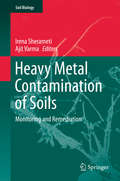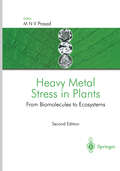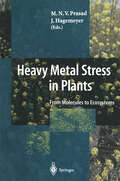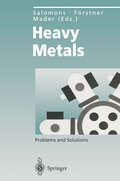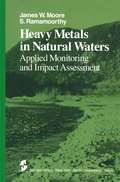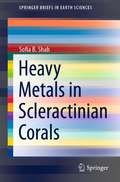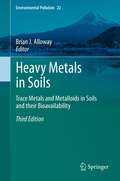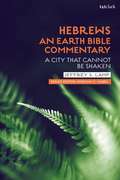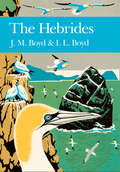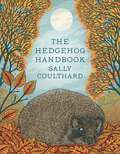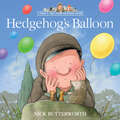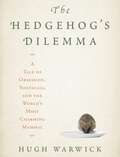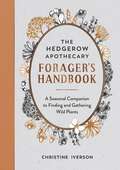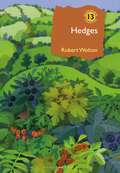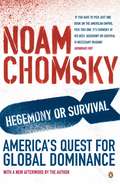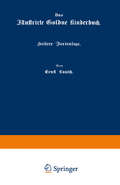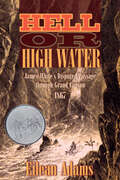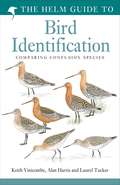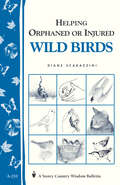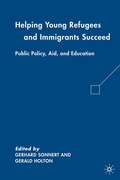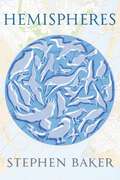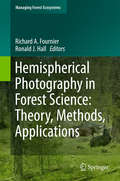- Table View
- List View
Heavy Metal Contamination of Soils: Monitoring and Remediation (Soil Biology #44)
by Irena Sherameti Ajit VarmaFollowing a description of the various sources and factors influencing the contents of heavy metal pollution in post-catastrophic and agricultural soils, subsequent chapters examine soil enzymes and eggs as bio-monitors, lead adsorption, the effects of arsenic on microbial diversity, and the effects of Mediterranean grasslands on abandoned mines. A third section focuses on the adaptation strategies used by plants and bacteria, such as Pinus sylvestris in industrial areas, and the rhizosphere in contaminated tropical soils and soil treated with sewage sludge. Further topics addressed include strategies of bioremediation, e.g. using transgenic plants as tools for soil remediation.This new volume on heavy metals in soil will be of interest to researchers and scholars in microbial and plant biotechnology, agriculture, the environmental sciences and soil ecology.
Heavy Metal Stress in Plants: From Biomolecules to Ecosystems
by M. N. V. PrasadWhilst heavy metal phytotoxicity has been known for more than a century, it is astonishing that interest in the effects of heavy metals on organisms has only recently received added attention. Research in the past years, however, has confirmed the immense damage by metal pollution to plants, the soil and ultimately to humans. This completely updated and enlarged second edition gives a state-of-the art review on both field and laboratory work. It deals with the various functional and ecological aspects of heavy metal stress on plants and outlines the scope for future research and the possibilities for remediation.
Heavy Metal Stress in Plants: From Molecules to Ecosystems
by M. N. V. Prasad Jürgen HagemeyerHeavy metal phytotoxicity has been known for more than a century. However, research in the past years has confirmed the immense damage by metal pollution to plants, the soil and ultimately to humans. By reviewing both field and laboratory work, this book deals with the various functional and ecological aspects of heavy metal stress on plants and outlines the scope for future research and the possibilities for remediation.
Heavy Metals: Problems and Solutions (Environmental Science and Engineering)
by Wim Salomons Ulrich Förstner Pavel Mader"Heavy Metals: Problems and Solutions" is divided into three sections dealing with basic geochemical processes, remediation and case studies. The basic geochemical processes are discussed with respect to mobility in the environment and impact as well as methods to derive guidelines for heavy metals. Remediation focuses on currently available methods to treat contaminated sediments and soils. In addition, it considers the concept of geochemical engineering for remediation of large areas contaminated by metals. A number of case studies of polluted sediments and soils and their environmental impact highlight the principles discussed in the first two sections.
Heavy Metals in Natural Waters: Applied Monitoring and Impact Assessment (Springer Series on Environmental Management)
by J.W. Moore S. RamamoorthyThis series is dedicated to serving the growing community of scholars and practitioners concerned with the principles and applications of environ mental management. Each volume is a thorough treatment of a specific topic of importance for proper management practices. A fundamental objective of these books is to help the reader discern and implement man's stewardship of our environment and the world's renewable re sources. For we must strive to understand the relationship between man and nature, act to bring harmony to it, and nurture an environment that is both stable and productive. These objectives have often eluded us because the pursuit of other individual and societal goals has diverted us from a course of living in balance with the environment. At times, therefore, the environmental manager may have to exert restrictive control, which is usually best applied to man, not nature. Attempts to alter or harness nature have often failed or backfired, as exemplified by the results of imprudent use of herbicides, fertilizers, water, and other agents. Each book in this series will shed light on the fundamental and applied aspects of environmental management. It is hoped that each will help solve a practical and serious environmental problem.
Heavy Metals in Scleractinian Corals (SpringerBriefs in Earth Sciences)
by Sofia B. ShahThis book provides an in-depth review of heavy metals in corals, describing the sources of heavy metals in the marine environment and their effect on corals. It is designed to serve as a unique reference for upcoming marine researchers and chemists, advanced undergraduate and postgraduate students as well as those interested in marine pollution with respect to heavy metals. The book explains the basics as well as the state-of-the-art regarding heavy metals and corals and is engaging and clearly written and narrated, providing readers with the fundamental tools about the subject matter that they need in their specific fields. It allows readers to understand and appreciate the interactions between the atmosphere, ocean, and the geosphere. Detailed reference is included for the benefit of the reader. The specific objectives of this book are (i) to inform/educate the reader about persistent pollutants such as heavy metals, (ii) to identify sources of heavy metals in the marine environment, (iii) to inform about route of exposure and uptake of the heavy metal pollutants by corals, (iv) to elaborate about the effect of heavy metal pollutants on the coral reef ecosystems, (v) to discuss the ways in which heavy metal regulation occurs in corals, (vi) to impact current knowledge regarding heavy metals in the marine environment, and (vii) to briefly show chemical analysis and instrumentation for analyzing heavy metals.
Heavy Metals in Soils: Trace Metals and Metalloids in Soils and their Bioavailability (Environmental Pollution #22)
by Brian J. AllowayThis third edition of the book has been completely re-written, providing a wider scope and enhanced coverage. It covers the general principles of the natural occurrence, pollution sources, chemical analysis, soil chemical behaviour and soil-plant-animal relationships of heavy metals and metalloids, followed by a detailed coverage of 21 individual elements, including: antimony, arsenic, barium, cadmium, chromium, cobalt, copper, gold, lead, manganese, mercury, molybdenum, nickel, selenium, silver, thallium, tin, tungsten, uranium, vanadium and zinc. The book is highly relevant for those involved in environmental science, soil science, geochemistry, agronomy, environmental health, and environmental engineering, including specialists responsible for the management and clean-up of contaminated land.
Hebrews: A City That Cannot Be Shaken (Earth Bible Commentary)
by Jeffrey S. LampIn this new ecological commentary on the letter to the Hebrews, Jeffrey S. Lamp makes use of approaches developed in the relatively new field of Ecological Hermeneutics to shed light upon the connection of Hebrews with Earth.Hebrews is frequently characterized as portraying a dualistic cosmology that diminishes the material world, muting the voice of Earth. Conversely, Lamp argues that though Hebrews cannot be construed as an ecological treatise, the contours of the letter's presentation may be subverted by reading from an ecological perspective, such that cues provided by the author of Hebrews serve as opportunities to hear Earth's voice in the letter. Three movements, corresponding to thematic interests of the author of Hebrews, form the framework of this ecological reading: the Son as the agent of creation, the Son depicted as the Second Adam, and the New Jerusalem as the eschatological dwelling place of God. This ecological reading of Hebrews aims to shape its readers into those who fulfill the soteriological aims of God in and for the world.
Hebrews: A City That Cannot Be Shaken (Earth Bible Commentary)
by Jeffrey S. LampIn this new ecological commentary on the letter to the Hebrews, Jeffrey S. Lamp makes use of approaches developed in the relatively new field of Ecological Hermeneutics to shed light upon the connection of Hebrews with Earth.Hebrews is frequently characterized as portraying a dualistic cosmology that diminishes the material world, muting the voice of Earth. Conversely, Lamp argues that though Hebrews cannot be construed as an ecological treatise, the contours of the letter's presentation may be subverted by reading from an ecological perspective, such that cues provided by the author of Hebrews serve as opportunities to hear Earth's voice in the letter. Three movements, corresponding to thematic interests of the author of Hebrews, form the framework of this ecological reading: the Son as the agent of creation, the Son depicted as the Second Adam, and the New Jerusalem as the eschatological dwelling place of God. This ecological reading of Hebrews aims to shape its readers into those who fulfill the soteriological aims of God in and for the world.
The Hebrides (Collins New Naturalist Library #76)
by J. M. Boyd I. L. BoydA complete natural history of the Hebrides – an area of great natural beauty, which draws back thousands of visitors year after year to its wonderful scenery and abundant wildlife.
The Hedgehog Handbook
by Sally Coulthard'Wonderful' Yorkshire Times'Not just a celebration of these enigmatic creatures, but also a timely alarm bell about their shrinking numbers' The Lady'Just about every hedgehog fact you could wish to know' Northern EchoHedgehogs, with their quiet determination and bristling, bumbling ways, are one of the most enduring symbols of the countryside and town gardens. The Hedgehog Handbook explores different facets of this enigmatic and much-admired mammal – from its eating and sleeping habits to its literary heritage and how we can help preserve this icon of rural life. Packed with inspirational quotes, entertaining facts, folklore and literary references, it's the perfect gift for anyone with a penchant for prickles.
Hedgehog’s Balloon (A Percy the Park Keeper Story)
by Nick ButterworthA funny Percy the Park Keeper story from highly regarded, award-winning author and illustrator Nick Butterworth, creator of One Snowy Night.
The Hedgehog's Dilemma: A Tale of Obsession, Nostalgia, and the World's Most Charming Mammal
by Hugh WarwickIn this wonderfully entertaining, adorable book, Hugh Warwick, an environmental writer and photographer, examines the relationship between the hedgehog and man, and how the hedgehog became so beloved. Traveling the globe in search of his quarry, Warwick eventually discovers a new breed called Hugh's Hedgehog.
The Hedgerow Apothecary Forager's Handbook: A Seasonal Companion to Finding and Gathering Wild Plants
by Christine IversonLearn to forage in the hedgerows like the herbalists of the pastAs many of us look for ways to live a more planet-friendly lifestyle, the sustainable and ethical art of foraging offers us a way to connect with the world around us. It is a practice rich in tradition and steeped in history, and one that links us to our past and our future.This foraging companion is designed to be taken with you on your adventures into the hedgerows, forests and woodland all year round. Helpfully arranged by season, this book includes clear photographs to aid plant identification, ideas on how best to prepare and preserve your finds, fascinating foraging and plant folklore, and handy pages to make your own notes and drawings.Additional features:Paperback and lightweight (approx. 330g) design, to allow you to take the book with you while foragingA month-by-month foraging calendarAdvice on foraging etiquette and tips for creating a forager’s toolkitThis is the essential guide to enjoying the bountiful delights of the hedgerows.
Hedges (British Wildlife Collection)
by Robert WoltonAn absorbing celebration of the ecology, biology and cultural history of the rich hedgerow heritage in the British Isles.Much of the UK is intensively farmed, and in such landscapes hedges are often the only refuge for wildlife. In addition to providing shelter, protection and food for animals, they also connect and bind together the patches of habitat that do remain, as well as playing vital roles in soil conservation and flood prevention – in short, they are vital for nature's recovery.In Hedges, Robert Wolton brings together decades of research, while also incorporating personal experiences from his farm in Devon, to explore the ecology, nature conservation and wider environmental values of our hedges. From improving water quality and producing wood fuel as a renewable energy source to the use of hedges in boosting crop pollination, this engaging and authoritative book will help to inspire people to value and look after the remarkably rich hedgerow heritage we have in the British Isles.Containing more than 300 photographs and figures, this latest addition to the British Wildlife Collection is a comprehensive commentary on hedges and our relationship with them.
Hedges (British Wildlife Collection)
by Robert WoltonAn absorbing celebration of the ecology, biology and cultural history of the rich hedgerow heritage in the British Isles.Much of the UK is intensively farmed, and in such landscapes hedges are often the only refuge for wildlife. In addition to providing shelter, protection and food for animals, they also connect and bind together the patches of habitat that do remain, as well as playing vital roles in soil conservation and flood prevention – in short, they are vital for nature's recovery.In Hedges, Robert Wolton brings together decades of research, while also incorporating personal experiences from his farm in Devon, to explore the ecology, nature conservation and wider environmental values of our hedges. From improving water quality and producing wood fuel as a renewable energy source to the use of hedges in boosting crop pollination, this engaging and authoritative book will help to inspire people to value and look after the remarkably rich hedgerow heritage we have in the British Isles.Containing more than 300 photographs and figures, this latest addition to the British Wildlife Collection is a comprehensive commentary on hedges and our relationship with them.
Hegemony or Survival: America's Quest for Global Dominance (American Empire Project Ser. #Vol. 185)
by Noam ChomskyHegemony or Survival is Noam Chomsky's essential polemic on American foreign policy.Noam Chomsky, the world's foremost intellectual activist, presents an irrefutable analysis of America's pursuit of total domination and the catastrophic consequences that are sure to follow.From the funding of repressive regimes to the current 'war on terror', from the toppling of governments opposing its beliefs to the invasion of Iraq, America pursues its global strategy no matter what the cost. With the rigour and insight that have made him our most important unraveller of accredited lies, Noam Chomsky reveals the truth and the true motives behind America's quest for dominance - and seeks also to show how the world may yet step back from the brink.'A devastating history of American foreign policy since 1945 as well as a dissection of the current "war on terror"' Tim Adams, Observer'Anybody who thinks about American foreign policy has to read and contemplate Hegemony or Survival' Independent'One of the radical heroes of our age. A towering intellect' GuardianNoam Chomsky is the author of numerous bestselling political books, including Hegemony or Survival, Failed States, Interventions, What We Say Goes, Hopes and Prospects, How the World Works and Occupy, all of which are published by Hamish Hamilton/Penguin.
Hell Or High Water: James White's Disputed Passage through Grand Canyon, 1867 (G - Reference, Information And Interdisciplinary Subjects Ser.)
by Eilean AdamsAlthough John Wesley Powell and party are usually given credit for the first river descent through the Grand Canyon, the ghost of James White has haunted those claims. White was a Colorado prospector, who, almost two years before Powell's journey, washed up on a makeshift raft at Callville, Nevada. His claim to have entered the Colorado above the San Juan River with another man (soon drowned) as they fled from Indians was widely disseminated and believed for a time, but Powell and his successors on the river publically discounted it. Colorado River runners and historians have since debated whether White's passage through Grand Canyon even could have happened. Hell or High Water is the first full account of White's story and how it became distorted and he disparaged over time. It is also a fascinating detective story, recounting how White's granddaughter, Eilean Adams, over decades and with the assistance of a couple of notable Colorado River historians who believed he could have done what he claimed, gradually uncovered the record of James White's adventure and put together a plausible narrative of how and why he ended up floating helplessly down a turbulent river, entrenched in massive cliffs, with nothing but a driftwood raft to carry him through.
The Helm Guide to Bird Identification
by Keith Vinicombe Alan HarrisThis book covers difficult identification issues by looking at tricky species pairs or groups of birds, and comparing and contrasting their respective features. Designed as a field companion, it supplements the standard field guides and provides much additional information. As well as detailed texts, the books include extensive illustrations of all relevant ages and plumages of the species concerned.
The Helm Guide to Bird Identification
by Keith Vinicombe Alan HarrisThis ebook covers difficult identification issues by looking at tricky species pairs or groups of birds, and comparing and contrasting their respective features. Designed as a field companion, it supplements the standard field guides and provides much additional information. As well as detailed texts, the books include extensive illustrations of all relevant ages and plumages of the species concerned.
Helping Orphaned or Injured Wild Birds: Storey's Country Wisdom Bulletin A-210 (Storey Country Wisdom Bulletin)
by Diane ScarazziniTo Help or Not to Help? When faced with an injured bird or orphaned nestling, most people want to help but don’t know how – and also fear doing more harm than good. In fact, many wild birds that appear to be in trouble don’t need assistance at all. How do you know whether a bird needs help? How do you know what sort of help the bird needs? In Helping Orphaned or Injured Wild Birds, you’ll find all the information you need on when and how to assist all kinds of birds, from wrens to raptors. You’ll learn how to: Identify whether a bird needs rescuingHelp a baby bird that’s fallen from its nestIdentify the age and species of an injured of orphaned birdPrepare emergency rations for a baby birdAdminister basic bird first-aid Locate a professional wildlife rehabilitator
Helping Young Refugees and Immigrants Succeed: Public Policy, Aid, and Education
by G. HoltonIn a unique effort, this book brings together, for the first time, scholarly analyses by eminent researchers of the historical, social, legal, and cultural influences on the young newcomers' lives as well as reports by practitioners in major aid organizations about the concrete work that their organizations have been carrying out.
Hemispheres: A Novel Of Family, Birds And Coming Home
by Stephen BakerSHORTLISTED FOR THE 2011 EAST MIDLANDS BOOK AWARDMoving from the gas-flares of Teesside, to marine adventures in the South Atlantic, Hemispheres is a salutary and searing debut novel for anyone who enjoyed Kes and The Northern Clemency.When sixteen-year-old Danny's father, Yan, leaves their Teesside home to fight in the Falklands War, he never returns and Danny imagines he is either dead or has abandoned him and his mother for good. So when, thirty years later, Yan reappears, there is much to be explained, and forgiven, if father and son are to reconcile their broken relationship. Yan has spent the lost years half a world away, adrift on a remarkable chain of adventures set in motion when he deserted from the army. But when he discovers he is dying from lung cancer, he returns to his homeland in the north-east of England to reconcile his damaged relationship with his son. Separated by years and experience, father and son find unexpected solace and harmony together through their shared love of birds and birdwatching. Hemispheres is a gloriously ambitious debut novel about family, destiny, nature and coming home.
Hemispherical Photography in Forest Science: Theory, Methods, Applications (Managing Forest Ecosystems #28)
by Richard A. Fournier Ronald J. HallThis book presents practical information about hemispherical photography from the perspectives of field data acquisition, image processing and information retrieval methods. This book is organized into three sections. The first section describes what is hemispherical photography and what are the fundamental elements of forest structure and light interactions within the forest canopy. The second section provides practical information about the equipment, procedures and tools for procuring, processing and analyzing hemispherical photographs. Armed with this information, the third section describes several applications of hemispherical photographs to forestry and natural resource assessment. The book concludes with a discussion about modelling tools and future directions of this rapidly growing field. There is currently no information source on the market that has this comprehensive range of topics combined in a single book. The book will appeal to academics, graduate students, natural resource professionals and researchers alike.
